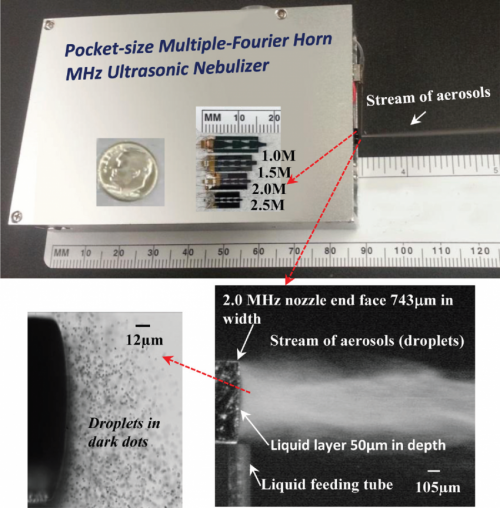A pocket-size ultrasonic nebulizer employing a novel nozzle improves inhalers

Inhalation is an increasingly important route for non-invasive drug delivery for both systemic and local applications. Control of particle size and output plays a critical role in the efficient and effective delivery of oft en expensive medications to the lung. Drugs designed to treat pulmonary diseases or for systemic absorption through the alveolar capillary bed require optimum particle sizes (1 to 6 μm) for effective delivery.
A team of researchers from the Department of Electrical Engineering and Computer Science at the University of California, Irvine has realized a novel device for inhalation drug delivery, which is capable of fulfilling needs unmet by current commercial devices. The precise control of particle size and much narrower particle size distribution achieved by the new device will improve targeting of treatment within the respiratory tract and improve delivery efficiency, resulting in better efficacy, fewer side effects, shorter treatment times, and lower medication costs compared with existing nebulizers. The core of the new delivery device is a centimeter-size clog-free silicon-based ultrasonic nozzle with multiple Fourier horns in resonance at megahertz (MHz) frequency. The dramatic resonance effect among the multiple horns and high growth rate of the MHz Faraday waves excited on a medicinal liquid layer together facilitate ejection of monodisperse droplets of desirable size range (2-5 μm) at low electrical drive power (<1.0 watt). The small nozzle requiring low drive power has enabled realization of a battery-run pocket-size (8.6 × 5.6 × 1.5 cm3) ultrasonic nebulizer. A range of drug substances have been successfully nebulized using the pocket-size unit with desirable aerosol sizes and output rate. The superior performance and batch fabrication economy of the miniaturized silicon-based ultrasonic nozzles have paved the way for imminent commercialization of the new technology. The report appears in the second issue of the journal Technology.
"Despite more than 180 years of continued interest and studies on Faraday waves since Faraday's 1831 classical experiment involving a water layer at very low drive frequency of 5 Hz, it was only through our invention and realization of MHz ultrasonic nozzles with multiple Fourier horns in resonance that the science and technical potential of Faraday waves at MHz frequency range were discovered, and led to a technology with immediate and important medical applications," says Chen S. Tsai, Chancellor's Professor and the PI of this study. Tsai says further, "The technology reported here may find a wide range of applications other than inhalation drug delivery such as synthesis of nano particles via spray drying or spray pyrolysis, sample injection in chemical analysis (e.g. mass spectroscopy), high-quality thin-film coating, 3-D photoresist coating of micro- and nano-structures in fabrication of nano-electronic and -photonic devices, fuel injection in combustion, delivery of lipid-based micro-encapsulated biological entities or genes, pharmaceutical preparation such as double emulsion, rapid heat removal in laser surgery, and rapid administration of cosmetics."
More information: www.worldscientific.com/doi/pd … 42/S233954781450006X
Provided by World Scientific Publishing




















